Our tangle for today is an easy grid-based one with lots of options to exercise your creativity with embellishments.
Flish is from New Jersey CZT Mimi Topping and it’s her first on the site.
Mimi shares two monotangle ZIAs featuring Flish, This first is on a Renaissance Tan Zentangle® tile.
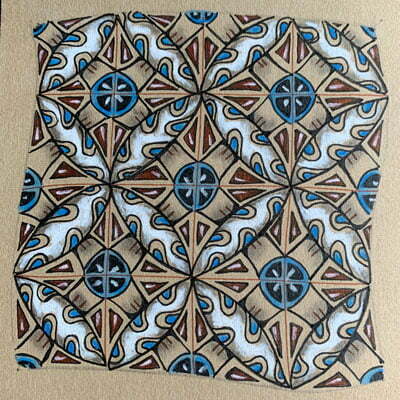
Mimi introduces herself and explains her inspiration for Flish:
I’m a CZT from class number nine. Covid has given me more time to explore my craft and I’m sharing my latest creation.
I was trying to create a different pattern and stumbled upon “flish”.
It made me think of flying fish at my mom’s back-yard pond in St. Augustine, FL.
{Aside: Wow, I can’t believe it’s already been six years since Robert and I moved back to South Florida from St. Augustine. It was too cold up there for us, and we missed the palm trees 🙂 }
So, what do we know about flying fish?
The Exocoetidae are a family of marine fish in the order Beloniformes class Actinopterygii, known colloquially as flying fish or flying cod. About 64 species are grouped in seven to nine genera.
While they cannot fly in the same way a bird does, flying fish can make powerful, self-propelled leaps out of the water where their long wing-like fins enable gliding for considerable distances above the water’s surface. The main reason for this behavior is thought to be to escape from predators.
Barbados is known as “the land of the flying fish”, and the fish is one of the national symbols of the country. The Exocet missile is named after them, as variants are launched from underwater, and take a low trajectory, skimming the surface, before striking their targets.
The oldest known fossil of a flying or gliding fish, Potanichthys xingyiensis, dates back to the Middle Triassic, 235–242 million years ago. However, this fossil is not related to modern flying fish, which evolved independently about 66 million years ago.
… Flying fish live in all of the oceans, particularly in tropical and warm subtropical waters.
… The flights of flying fish are typically around 50 m (160 ft), though they can use updrafts at the leading edge of waves to cover distances up to 400 m (1,300 ft). They can travel at speeds of more than 70 km/h (43 mph). Maximum altitude is 6 m (20 ft) above the surface of the sea.
That’s a lot more than I did before! To see what flying fish look like, check out the images on this Google search.
Mimi’s second ZIA demonstrates Flish as a ribbon-style tangle. And just as a reminder, most grid-based tangles make great ribbons or borders …
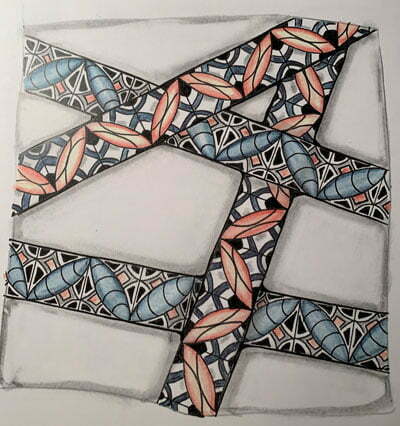
For my example of Flish I wanted to keep it to Zentangle’s non-objective aspect, and so it wasn’t a literal “fish” looking tangle I left out the “eyes”, as did Mimi in her two ZIAs above.
Mimi illustrates the step-by-step instructions for drawing Flish below and she includes several examples of ways to vary and embellish her tangle. You can also find Mimi here on her website.
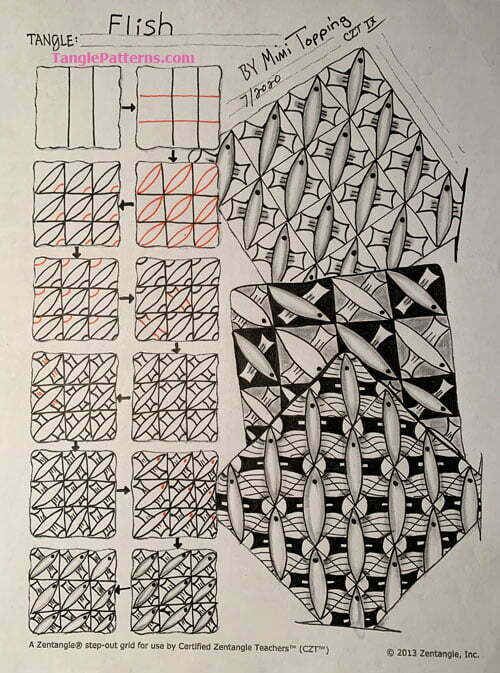
Image copyright the artist and used with permission, ALL RIGHTS RESERVED. These images are for your personal offline reference only. Please feel free to refer to the images to recreate this tangle in your personal Zentangles and ZIAs. However the artist and TanglePatterns.com reserve all rights to the images and they must not be publicly pinned, altered, reproduced or republished. Thank you for respecting these rights. For more information, click on the image for a discussion entitled “Artists for Respect” by several prominent artists. “Integrity is doing the right thing, even when no one is watching.” ~ C.S. Lewis
As you enjoy any of the tangles on the site, please leave a comment of thanks and encouragement to show the artists you appreciate them for sharing their creativity to inspire yours. Your thanks helps motivate them to continue to share! And please share a link to your favorite tangles on social media. Thanks!
Check out the tag mimit for more of Mimi’s tangles on TanglePatterns.com.
That’s it for the first week of August, see you again next week for more tangling delights!
Related Links
- Looking for tangles by Artist or Type? For details visit the ABOUT > HOW TO FIND TANGLES BY ARTIST OR TYPE page on the top menu bar of any page on the site.
- What is a Zentangle? — if you are new to the Zentangle Method, start here for the fundamentals.
- Zentangle terminology — a glossary of terms used in this art form.
- How to use the site — an excellent free video tutorial showing how to use the site as well as pointing out lots of useful features you might have missed.
- Linda's List of Zentangle-Original Patterns — here is the complete list of original tangles (aka "official tangles") created and introduced by founders Rick Roberts and Maria Thomas, including those not published online. If you are new to the Zentangle Method I highly recommend learning a few of the published Zentangle classics first.
- "A Zentangle has no up or down and is not a picture of something, so you have no worries about whether you can draw a hand, or a duck. You always succeed in creating a Zentangle." Patterns that are drawings of a recognizable naturalistic or actual object, figure, or scene, are not tangles. A pattern is not always a tangle — here's what makes a tangle. TIP: tangles never start with pencil planning.
- Un motif n’est pas toujours un tangle — Qu’est-ce qu’un tangle ?
- Un diseño no es siempre un tangle — ¿Qué es un tangle?
- How to submit your pattern deconstruction to TanglePatterns
- For lots of great FREE tutorials on TanglePatterns, click on the TUTORIALS link in the pink alphabetic menu bar below the tangle images at the top of any page.
- Strings! Have we got STRINGS! Click on the STRINGS link in the pink alphabetic menu bar below the tangle images at the top of any page for 250 different (free) Zentangle-starters. More than enough for any lifetime!
- Never miss a tangle! FREE eMAIL NEWSLETTER - visit the Here's how to SUBSCRIBE button (top of left sidebar on any page) and sign up to get notices delivered free to your inbox.
- If you have questions about the TanglePatterns.com TANGLE GUIDE, visit the BOOK REVIEWS tab on the top menu bar of any page on the site for COMPLETE details!
|
.oOo. |
|
Enhance your Zentangle experience while supporting TanglePatterns: |
|
CURRENT EDITION! TanglePatterns.com TANGLE GUIDE, 2025 Edition |
|
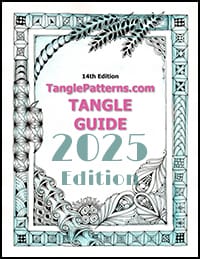 |
The 14th Edition of the TanglePatterns.com TANGLE GUIDE is an instant-download 117-page interactive digital eBook/PDF containing over 2,000 tangles on the site from May 2010 through December 31, 2024. It's a great resource and a must-have digital tool for using the site. Visit the STORE > E-BOOKS page and help keep TanglePatterns.com going by getting your copy now! |
|
"Linda, Thank you! I was relying on too few and getting stuck after 3 years of daily working with Zentangle. This has inspired me to ‘begin again’ with renewed excitement." ~ Barbara R. |
|
| See the BOOK REVIEWS page for more details on its features and view a sample page. Note: this is a digital product you download immediately when you place your order, nothing will be physically mailed to you. | |
| If you're new to Zentangle® and tangling, my TanglePatterns.com BEGINNER'S GUIDE TO ZENTANGLE is just what you need to get started. Also available en Français and en Español. | |
|
|
|
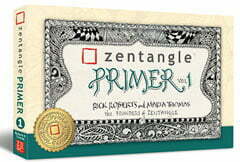 |
This is the only Zentangle book you'll ever need: the fabulous Zentangle PRIMER Vol 1. It's your CZT-in-a-book by the founders of Zentangle®. Visit the STORE tab on the top menu bar or click on the image. For more about the content and to read the rave reviews, visit the BOOK REVIEWS tab. |
| Now available in KINDLE format for $9.99. Spanish Edition here. Japanese Edition here. | |
| "Absolutely the best Zentangle Book yet! As an accomplished artist I used to think I did not need instruction on this art form. How wrong I was! My tangling improved by leaps and bounds after reading this book. If you think you have Zentangle down then you need this book more than ever!" ~ Kris H | |
|
|
|
|
.oOo. |
|






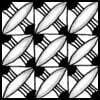


C’est magnifique. Mille bravos pour ma 1ère newsletter
Mimi – Flish. What fun. I’m going to look specifically for flying fish next time I’m in Florida and definitely use this tangle in one of my many souvenir tiles (even though they don’t look like ‘a thing!’)
Linda – I must say that the extra detail you add to the descriptions for new tangle discoveries intrigues me. Many thanks.
My best to both of you. Linda Dochter, CZT
Love this little flish fragment. And thanks Linda for a good read on flying fish. Have always enjoyed seeing them when we were on cruises.
Mimi,
Thank you. This tangle has so many uses and is beautiful. I’m sure I’ll use it!